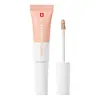What's inside
What's inside
 Key Ingredients
Key Ingredients

No key ingredients
 Benefits
Benefits

 Concerns
Concerns

 Ingredients Side-by-side
Ingredients Side-by-side

Water
Skin ConditioningCI 77891
Cosmetic ColorantCaprylic/Capric Triglyceride
MaskingDimethicone
EmollientTitanium Dioxide
Cosmetic ColorantHydrogenated Polyisobutene
EmollientNiacinamide
SmoothingGlycerin
HumectantLauryl PEG-8 Dimethicone
Synthetic Fluorphlogopite
Pentylene Glycol
Skin ConditioningButylene Glycol
HumectantPhenyl Trimethicone
Skin ConditioningCI 77492
Cosmetic ColorantPanax Ginseng Root Extract
EmollientGlycyrrhiza Glabra Root Extract
BleachingDioscorea Villosa Root Extract
Skin ConditioningKigelia Africana Fruit Extract
Skin ConditioningEquisetum Giganteum Extract
Skin ConditioningSaccharomyces/Panax Ginseng Flower Ferment Extract
AntioxidantEscin
TonicMagnesium Sulfate
Vinyl Dimethicone/Methicone Silsesquioxane Crosspolymer
Sorbitan Isostearate
EmulsifyingAluminum Hydroxide
EmollientTriethoxycaprylylsilane
Propanediol
SolventStearic Acid
CleansingAlumina
AbrasiveDisteardimonium Hectorite
StabilisingCaprylyl Glycol
EmollientGlyceryl Caprylate
Emollient1,2-Hexanediol
Skin ConditioningTrisodium Ethylenediamine Disuccinate
Biosaccharide Gum-1
HumectantEthylhexylglycerin
Skin ConditioningCI 77491
Cosmetic ColorantCI 77499
Cosmetic ColorantWater, CI 77891, Caprylic/Capric Triglyceride, Dimethicone, Titanium Dioxide, Hydrogenated Polyisobutene, Niacinamide, Glycerin, Lauryl PEG-8 Dimethicone, Synthetic Fluorphlogopite, Pentylene Glycol, Butylene Glycol, Phenyl Trimethicone, CI 77492, Panax Ginseng Root Extract, Glycyrrhiza Glabra Root Extract, Dioscorea Villosa Root Extract, Kigelia Africana Fruit Extract, Equisetum Giganteum Extract, Saccharomyces/Panax Ginseng Flower Ferment Extract, Escin, Magnesium Sulfate, Vinyl Dimethicone/Methicone Silsesquioxane Crosspolymer, Sorbitan Isostearate, Aluminum Hydroxide, Triethoxycaprylylsilane, Propanediol, Stearic Acid, Alumina, Disteardimonium Hectorite, Caprylyl Glycol, Glyceryl Caprylate, 1,2-Hexanediol, Trisodium Ethylenediamine Disuccinate, Biosaccharide Gum-1, Ethylhexylglycerin, CI 77491, CI 77499
Ingredients Explained
These ingredients are found in both products.
Ingredients higher up in an ingredient list are typically present in a larger amount.
1,2-Hexanediol is a synthetic liquid and another multi-functional powerhouse.
It is a:
- Humectant, drawing moisture into the skin
- Emollient, helping to soften skin
- Solvent, dispersing and stabilizing formulas
- Preservative booster, enhancing the antimicrobial activity of other preservatives
Butylene Glycol (or BG) is used within cosmetic products for a few different reasons:
Overall, Butylene Glycol is a safe and well-rounded ingredient that works well with other ingredients.
Though this ingredient works well with most skin types, some people with sensitive skin may experience a reaction such as allergic rashes, closed comedones, or itchiness.
Learn more about Butylene GlycolCaprylyl Glycol is a humectant and emollient, meaning it attracts and preserves moisture.
It is a common ingredient in many products, especially those designed to hydrate skin. The primary benefits are retaining moisture, skin softening, and promoting a healthy skin barrier.
Though Caprylyl Glycol is an alcohol derived from fatty acids, it is not the kind that can dry out skin.
This ingredient is also used as a preservative to extend the life of products. It has slight antimicrobial properties.
Learn more about Caprylyl GlycolCi 77491 is also hydrated iron III oxide. It's sole purpose is to give a red/pink hue to products.
Iron III oxides are classified as inorganic chemicals for coloring.
Synthetically created Ci 77491 is considered safer than those naturally found. This is because the synthetically created version may contain less impurities. Iron oxides are generally non-toxic and non-allergenic.
Learn more about CI 77491Ci 77492 is also hydrated iron III oxide. It's sole purpose is to give a yellow hue to products.
Iron III oxides are classified as inorganic chemicals for coloring.
Synthetically created Ci 77492 is considered safer than those naturally found. This is because the synthetically created version may contain less impurities. Iron oxides are generally non-toxic and non-allergenic.
Learn more about CI 77492Ci 77499 is also hydrated iron III oxide. It is created from mixing red and black iron oxides. This helps give shades of darkness to a product.
Iron III oxides are classified as inorganic chemicals for coloring.
Ci 77891 is a white pigment from Titanium dioxide. It is naturally found in minerals such as rutile and ilmenite.
It's main function is to add a white color to cosmetics. It can also be mixed with other colors to create different shades.
Ci 77891 is commonly found in sunscreens due to its ability to block UV rays.
Learn more about CI 77891Ethylhexylglycerin (we can't pronounce this either) is commonly used as a preservative and skin softener. It is derived from glyceryl.
You might see Ethylhexylglycerin often paired with other preservatives such as phenoxyethanol. Ethylhexylglycerin has been found to increase the effectiveness of these other preservatives.
Water. It's the most common cosmetic ingredient of all. You'll usually see it at the top of ingredient lists, meaning that it makes up the largest part of the product.
So why is it so popular? Water most often acts as a solvent - this means that it helps dissolve other ingredients into the formulation.
You'll also recognize water as that liquid we all need to stay alive. If you see this, drink a glass of water. Stay hydrated!
Learn more about Water